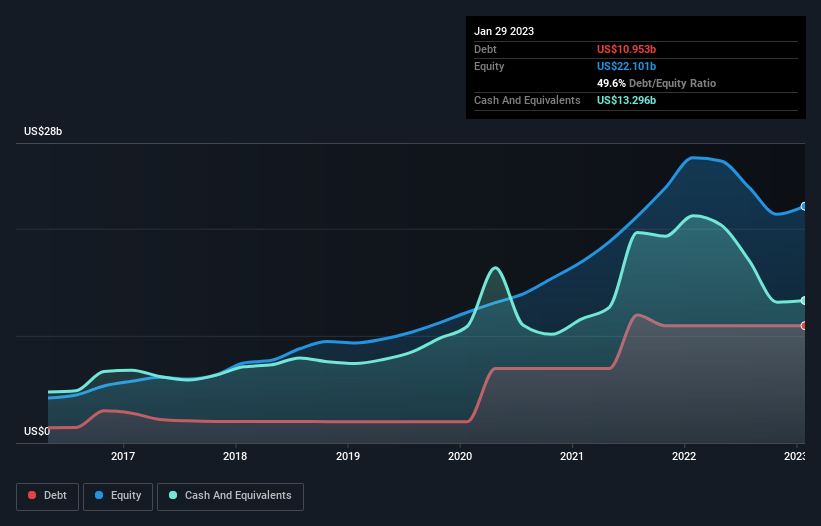Legendary fund manager Li Lu (who Charlie Munger backed) once said, ‘The biggest investment risk is not the volatility of prices, but whether you will suffer a permanent loss of capital.’ So it might be obvious that you need to consider debt, when you think about how risky any given stock is, because too much debt can sink a company. Importantly, NVIDIA Corporation (NASDAQ:NVDA) does carry debt. But should shareholders be worried about its use of debt?
When Is Debt A Problem?
Debt is a tool to help businesses grow, but if a business is incapable of paying off its lenders, then it exists at their mercy. In the worst case scenario, a company can go bankrupt if it cannot pay its creditors. However, a more common (but still painful) scenario is that it has to raise new equity capital at a low price, thus permanently diluting shareholders. Of course, plenty of companies use debt to fund growth, without any negative consequences. The first step when considering a company’s debt levels is to consider its cash and debt together.
See our latest analysis for NVIDIA
What Is NVIDIA’s Debt?
As you can see below, NVIDIA had US$11.0b of debt, at January 2023, which is about the same as the year before. You can click the chart for greater detail. However, it does have US$13.3b in cash offsetting this, leading to net cash of US$2.34b.
How Healthy Is NVIDIA’s Balance Sheet?
The latest balance sheet data shows that NVIDIA had liabilities of US$6.56b due within a year, and liabilities of US$12.5b falling due after that. Offsetting this, it had US$13.3b in cash and US$3.83b in receivables that were due within 12 months. So it has liabilities totalling US$1.96b more than its cash and near-term receivables, combined.
This state of affairs indicates that NVIDIA’s balance sheet looks quite solid, as its total liabilities are just about equal to its liquid assets. So while it’s hard to imagine that the US$688.8b company is struggling for cash, we still think it’s worth monitoring its balance sheet. Despite its noteworthy liabilities, NVIDIA boasts net cash, so it’s fair to say it does not have a heavy debt load!
In fact NVIDIA’s saving grace is its low debt levels, because its EBIT has tanked 44% in the last twelve months. When a company sees its earnings tank, it can sometimes find its relationships with its lenders turn sour. The balance sheet is clearly the area to focus on when you are analysing debt. But ultimately the future profitability of the business will decide if NVIDIA can strengthen its balance sheet over time. So if you want to see what the professionals think, you might find this free report on analyst profit forecasts to be interesting.
But our final consideration is also important, because a company cannot pay debt with paper profits; it needs cold hard cash. While NVIDIA has net cash on its balance sheet, it’s still worth taking a look at its ability to convert earnings before interest and tax (EBIT) to free cash flow, to help us understand how quickly it is building (or eroding) that cash balance. During the last three years, NVIDIA generated free cash flow amounting to a very robust 82% of its EBIT, more than we’d expect. That puts it in a very strong position to pay down debt.
Summing Up
We could understand if investors are concerned about NVIDIA’s liabilities, but we can be reassured by the fact it has has net cash of US$2.34b. And it impressed us with free cash flow of US$3.8b, being 82% of its EBIT. So we don’t have any problem with NVIDIA’s use of debt. The balance sheet is clearly the area to focus on when you are analysing debt. But ultimately, every company can contain risks that exist outside of the balance sheet. To that end, you should be aware of the 3 warning signs we’ve spotted with NVIDIA .
At the end of the day, it’s often better to focus on companies that are free from net debt. You can access our special list of such companies (all with a track record of profit growth). It’s free.
Have feedback on this article? Concerned about the content? Get in touch with us directly. Alternatively, email editorial-team (at) simplywallst.com.
This article by Simply Wall St is general in nature. We provide commentary based on historical data and analyst forecasts only using an unbiased methodology and our articles are not intended to be financial advice. It does not constitute a recommendation to buy or sell any stock, and does not take account of your objectives, or your financial situation. We aim to bring you long-term focused analysis driven by fundamental data. Note that our analysis may not factor in the latest price-sensitive company announcements or qualitative material. Simply Wall St has no position in any stocks mentioned.
Join A Paid User Research Session
You’ll receive a US$30 Amazon Gift card for 1 hour of your time while helping us build better investing tools for the individual investors like yourself. Sign up here







